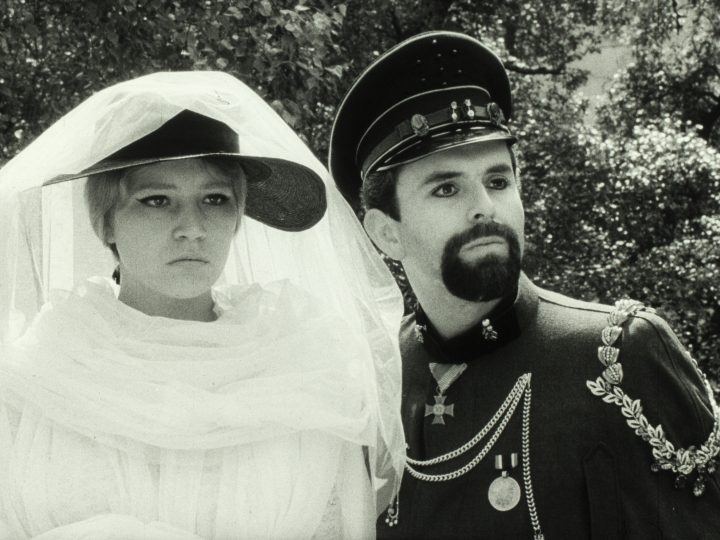In the second half of the 1960s, films in the style of cinéma vérité were on the ebb in Czechoslovakia. With a feeling that the given poetics were exhausted, and in their desire to try something new, New Wave filmmakers were inclined to make stylised parables. An example is Martyrs of Love (Mučedníci lásky, 1967), for a long time the last film that Jan Němec made in his homeland. This unclassifiable experiment enchanted by the beginnings of cinema, music and poetry ranked among his most successful films (until 1974 it attracted around 98,000 viewers), but at the same time, it wasn’t as well received by critics as his previous films Diamonds of the Night (Démanty noci, 1964) and The Party and the Guests (O slavnosti a hostech, 1966).
If former Czechoslovak president Antonín Novotný had had his way, the film career of Jan Němec would have ended after The Party and the Guests as it was assessed as too piercing a political satire. But before the ban came into force, Němec, with the creative group Novotný-Kubala, arranged a production of a purely apolitical literary script that he wrote with Ester Krumbachová. Originally, it comprised only two 20-minute stories, named in the film Temptation of a Man-in-Charge (Pokušení manipulanta) and Nastěnka’s Dreams (Nastěnčiny sny). When the project was approved, Němec and Krumbachová expanded their literary script with a third story called Adventures of Rudolf the Orphan (Dobrodružství sirotka Rudolfa).
Němec and Krumbachová created three variations on the theme of unrequited love. In “Man-in-Charge”, they materialise erotic dreams of a young clerk unable to step out of his work and relationship routines. In “Nastěnka”, we contrastively watch female notions of men and love. “Rudolf”, the only story with a more compact plot, connects motifs and characters from the previous two love adventures apparently taking place largely in the heads of the characters. All three stories, much like Diamonds of the Night, variously expand the border between actuality and imagination, dreams and reality.
“Man-in-Charge” is most noticeably anchored in Prague and uses the sounds of the streets to play a symphony reminiscent, among other things, of the first sound films of René Clair. The image composition, on the other hand, creates uncertainty as to whether we are seeing the same things as the main hero or just his memories and fantasies. “Nastěnka” has flashbacks and visions embedded in other flashbacks and visions without a clearly defined solid and realistic foundation for everything else. Also Rudolf’s encounters with a girl, who is possibly dreamy in several ways, take place in a dream-like atmosphere. We can only be certain that everything is just a film and a game, which, given the fact it is a work enchanted by the poetics of early cinema and the illusionary nature of film, can be considered an intention of the authors.
The characters, portrayed according to methods from the early days of cinematography and exclusively by non-actors, are defined mainly by the settings, costumes and movements (most noticeably in the case of Rudolf, played by choreographer Josef Koníček). Parts of sentences don’t bear much meaning and are of no help in understanding the heroes. A “manual” to the tragicomic stories of individual martyrs can be found in lyrics of songs sung by Marta Kubišová, Karel Gott and Eva Olmerová and written by Ester Krumbachová. It wasn’t her first musical project. She had worked on The Lost Revue (Ztracená revue, 1961) and two years after Martyrs, she collaborated with Němec and Kubišová on Necklace of Melancholy (Náhrdelník melancholie, 1968). Musical performances in the film interlace with various allusions to slapstick comedy (during preparations, Němec watched Chaplin’s films, but there is also a distinct influence of other early comedies) and by extension also to cinema itself as a showcase of spectacles not necessarily united by a story or a genre. Similarly, Martyrs oscillates between comedy, erotica, sentiment and melancholy, alternate various rhythms and musical styles and creates a tonally fluctuating pastiche. Apart from Krumbachová, who traditionally contributed to the film’s artistic style and costumes, it was also cinematographer Miroslav Ondříček who contributed to the stylistic distinction of individual stories.
The anarchist combination of lightness and naivety of old films with the tragicality of unfulfilled (erotic) desires, failing communication and complex narrative structure led to a certain perplexity among viewers and critics alike. Some demanded unity from a film whose governing principle is variability. Others appreciated its baroque imagination and efforts to entertain viewers in an unconventional way. Martyrs of Love was also screened at Locarno, Mannheim and Vienalle and received mixed reviews.
After finishing Martyrs, Němec proposed several projects to Barrandov Studio. But he wasn’t allowed to do any of them. We can speculate as to how big a role – apart from the aforementioned ban – played an interpellation by MP Jaroslav Pružinec at the National Assembly in May 1967. Appalled, Pružinec primarily demanded a complete ban on distribution of Daisies (Sedmikrásky, 1966) and The Party and the Guests (O slavnosti a hostech, 1966). But in his critical tirade, he mentioned also Martyrs of Love. In August 1967, Němec in any case resigned from Barrandov. At the start of the following year, he started filming for television. At the end of 1968, however, another ban came, but this time more or less definitive.
Martyrs of Love (Czechoslovakia 1966), Director: Jan Němec, Script: Jan Němec, Ester Krumbachová, DoP: Miroslav Ondříček, Starring: Petr Kopřiva, Marta Kubišová, Jiří Reichel, Zdena Korčáková, Hana Kuberová, Karel Gott, Jan Klusák, Jan Krumbach, Jana Dufková, Josef Koníček and many others. Film Studios Barrandov, 69 mins.


